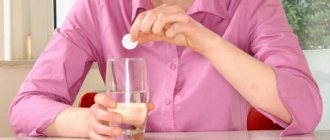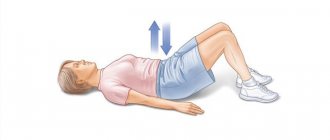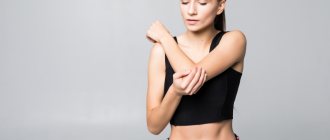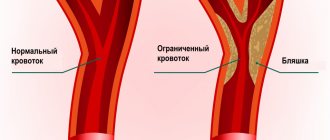"Magic" pills
There is a group of drugs collectively called non-steroidal anti-inflammatory drugs (NSAIDs), which we all have taken at least once in our lives, and many regularly. These are drugs that have analgesic, anti-inflammatory and/or antipyretic effects. Examples include Aspirin, Nurofen, Nice, Ketanov, Ketoprofen and others. Considering the “magical effects” of their action - relieving inflammation, pain and fever - they are prescribed by almost everyone, everyone, always. Prescribed by traumatologists, rheumatologists, therapists, ENT specialists, dentists. Plus, they can be purchased completely freely at any pharmacy. But, along with the “magical properties”, these drugs have a number of side effects that can be divided into 2 groups: cardio risks and gastro risks. Actually, gastrorisks will be discussed in this article.
Abbreviation NSAID
- does this tell you anything? If not, then we suggest expanding your horizons somewhat and finding out what these mysterious four letters mean. Read the article and everything will become absolutely clear. We hope that it will be not only informative, but also interesting!
NSAIDs stand for non-steroidal anti-inflammatory drugs - drugs are very popular and popular nowadays, because they can simultaneously eliminate pain and relieve inflammation in a variety of organs of our body.
If until now you have never had a need to take NSAIDs, this can be considered almost a miracle. You are one of the rare lucky ones, really, your health is enviable! NSAIDs are, let’s get ahead of the next question and immediately talk about the definition of the word “non-steroidal”, which means that these drugs are non-hormonal, i.e. do not contain any hormones. And this is very good, because everyone knows how unpredictable and dangerous hormonal drugs can be.
Most popular NSAIDs
If you think that NSAIDs are drugs whose names are rarely spoken in everyday life, then you are mistaken.
Many people do not even realize how often we have to use non-steroidal anti-inflammatory drugs to cure various ailments that have accompanied the human race since the expulsion of Adam and Eve from paradise.
Read the list of such products; you probably have some of them in your home medicine cabinet. So, NSAIDs include medications such as: Aspirin, Amidopyrine, Analgin, Piroxicam, Bystrumgel, Diclofenac, Ketoprofen, Indomethacin, Ketorol, Naproxen, “Ketorolac”, “Flurbiprofen”, “Voltarengel”, “Nimesil”, “Diclofenac”, “Ibuprofen”, “Indopan”, “Iprene”, “Upsarin UPSA”, “Ketanov”, “Mesulide”, “Movalis”, “ Nise", "Nurofen", "Ortofen", "Trombo ACC", "Ultrafen", "Fastum", "Finalgel".
Yes, these are all NSAID drugs. The list, although large, is, of course, far from complete. And yet, it gives a good idea of the variety of modern non-steroidal anti-inflammatory drugs.
Some historical facts
The first primitive NSAID drugs were known to people in ancient times. For example, in Ancient Egypt, willow bark, a natural source of salicylates and one of the first non-steroidal anti-inflammatory drugs, was widely used to relieve fever and pain. And even in those distant times, healers treated their patients suffering from joint pain and fever with decoctions of myrtle and lemon balm - they also contain salicylic acid.
In the mid-19th century, chemistry began to develop rapidly, which gave impetus to the development of pharmacology. At the same time, the first studies of the compositions of medicinal substances obtained from plant materials began to be carried out. Pure salicin from willow bark was synthesized in 1828 - this was the first step towards the creation of the familiar Aspirin.
But it will take many years of scientific research before this medicine comes to light. A grandiose event took place in 1899. Doctors and their patients quickly appreciated the benefits of the new drug. In 1925, when a terrible influenza epidemic hit Europe, Aspirin became a savior for a huge number of people.
And in 1950, this non-steroidal anti-inflammatory drug was included in the Guinness Book of Records as the painkiller with the largest sales volume. Well, later pharmacists created other non-steroidal anti-inflammatory drugs (NSAIDs).
For what diseases are non-steroidal anti-inflammatory drugs used?
The range of uses of NSAIDs is very wide. They are very effective in treating both acute and chronic diseases accompanied by pain and inflammation.
Nowadays, research is in full swing to study the effectiveness of these drugs in the treatment of heart and vascular diseases. And today almost everyone knows that they can be used for pain in the spine (NSAIDs for osteochondrosis are a real salvation).
Here is a list of painful conditions in the event of which the use of various non-steroidal anti-inflammatory drugs is indicated: Fever. Headaches, migraines. Renal colic. Rheumatoid arthritis. Gout. Arthrosis. Osteoarthritis. Dysmenorrhea. Inflammatory arthropathy (psoriatic arthritis, ankylosing spondylitis, Reiter's syndrome). Postoperative pain syndrome. Pain syndrome from mild to moderate severity due to injuries and various inflammatory changes.
Classification of NSAIDs according to their chemical structure
By reading this article, you have already had the opportunity to see that there are a lot of non-steroidal anti-inflammatory drugs. To navigate among them at least a little better, let's start classifying these funds.
First of all, they can be divided as follows: a group - acids and a group of NSAIDs - non-acid derivatives.
The first include: - Salicylates (you can immediately remember about “Aspirin”). — Derivatives of phenylacetic acid (“Aceclofenac”, “Diclofenac”, etc.). - Pyrazolidines (metamizole sodium, known to most of us as “Analgin”, “Phenylbutazone, etc.). — Oxicams (“Tenoxicam”, “Meloxicam”, “Piroxicam”, “Tenoxicam”). — Derivatives of indoleacetic acid (“Sulindac”, “Indomethacin”, etc.). — Derivatives of propionic acid (“Ibuprofen”, etc.).
The second group is: - Sulfonamide derivatives (“Celecoxib”, “Nimesulide”, “Rofecoxib”). — Alkanons (“Nabumeton”).
Classification of non-steroidal anti-inflammatory drugs according to their effectiveness
The use of NSAIDs for osteochondrosis and in the treatment of other joint diseases can literally work wonders. But, unfortunately, not all drugs are equal in their effectiveness. The undisputed leaders among them can be considered: Diclofenac, Ketoprofen, Indomethacin, Flurbiprofen, Ibuprofen and some other drugs.
The listed medications can be called basic; that is, on their basis, new NSAIDs can be developed and supplied to the pharmacy chain, but under a different changed name and often at a higher price. To avoid wasting your money, study the next chapter thoroughly.
The information contained in it will help you make the right choice. What you need to pay attention to when choosing a medicine NSAIDs are, for the most part, excellent modern drugs, but when you come to the pharmacy, it is better to be aware of some of the nuances. Which ones? But read it! For example, you are faced with a choice of what is better to buy: Diclofenac, Ortofen or Voltaren. And you are trying to ask the pharmacist which of these drugs is better. Most likely, they will recommend you the one that is more expensive. But the fact is that the composition of the listed drugs is almost identical. And the difference in names is explained by the fact that they were produced by different companies, which is why the brands differ from each other.
The same can be said, for example, about “Methindole” and “Indomethacin” or “Ibuprofen” and “Brufen”, etc. To sort out the confusion, always look carefully at the packaging, because the main active ingredient of the drug must be indicated there facilities. Only it will most likely be written in small letters.
But that is not all. Or rather, it’s not that simple! Using an NSAID analogue of a drug that you are familiar with can unexpectedly cause an allergic reaction or side effects that you have never experienced before. What's the matter? The reason may lie in additional additives, which, of course, nothing was written about on the packaging. This means that you also need to study the instructions.
Another possible reason for the different results of analog drugs is the difference in dosage. Ignorant people often do not pay any attention to this, but in vain. After all, small tablets can contain a “horse” dose of the active substance. And, conversely, pills or capsules of huge sizes, it happens, consist of fillers by as much as 90 percent. Sometimes drugs are also produced in retardated form, i.e., as long-acting (prolonged) drugs. An important feature of such drugs is the ability to be absorbed gradually, due to which their effect can last a whole day. This drug does not need to be taken 3 or 4 times a day; a single dose will be sufficient. This feature of the medicine should be indicated on the packaging or directly in the name. For example, “Voltaren” in a prolonged form is called “Voltaren-retard”.
List of analogues of known drugs
We are publishing this little cheat sheet in the hope that it will help you better navigate the many beautiful pharmacy packaging. Let's say you immediately need effective NSAIDs for arthrosis to relieve excruciating pain. Take out your cheat sheet and read the following list:
- Analogs of “Diclofenac”, in addition to the already mentioned “Voltaren” and “Ortofen”, are also “Diclofen”, “Dicloran”, “Diclonac”, “Rapten”, “Diclobene”, “Artrosan”, “Naklofen”.
- "Indomethacin" is sold under such brands as "Indomin", "Indotard", "Metindol", "Revmatin", "Indobene", "Inteban".
- Analogues of "Piroxicam": "Erazon", "Pirox", "Roxicam", "Pirocam".
- Analogues of "Ketoprofen": "Flexen", "Profenid", "Ketonal", "Artrosilene", "Knavon".
- The popular and inexpensive Ibuprofen is included in such drugs as Nurofen, Reumafen, Brufen, Bolinet.
Rules for taking NSAIDs
Taking NSAIDs can be accompanied by a number of side effects, so it is recommended to follow these rules when taking them:
- Reading the instructions and following the recommendations it contains are mandatory!
- When taking a capsule or tablet, take it with a glass of water to protect your stomach. This rule must be followed even if you are taking the most modern drugs (which are considered safer), because extra precaution never hurts;
- Do not lie down after taking the drug for about half an hour. The fact is that gravity will facilitate better passage of the capsule down the esophagus;
- It is better to avoid alcoholic beverages, since NSAIDs and alcohol combined together are an explosive mixture that can cause various stomach diseases.
- You should not take two different non-steroidal drugs on the same day - this will not increase the positive result, but, most likely, will add up to the side effects.
- If the medicine does not help, consult your doctor; perhaps the dose you were prescribed was too small.
Side effects and nonsteroidal gastropathy
Now you have to find out what NSAID gastropathy is. Unfortunately, all NSAIDs have significant side effects. They have a particularly negative effect on the gastrointestinal tract. Patients may be bothered by symptoms such as nausea (sometimes very severe). Heartburn. Vomit. Dyspepsia. Gastrointestinal bleeding. Diarrhea. Ulcer of the duodenum and stomach.
All of the above troubles are NSAID gastropathy. This is why doctors so often try to prescribe their patients the lowest possible doses of classic non-steroidal anti-inflammatory drugs. To minimize harmful effects on the stomach and intestines, it is recommended that you never take such medications on an empty stomach and only do so after a large meal.
But problems with the digestive system are not all the side effects that some NSAIDs can cause. Certain drugs can have a bad effect on the heart and also on the kidneys. Sometimes taking them can be accompanied by headache and dizziness.
Another serious problem is that they have a destructive effect on intra-articular cartilage (of course, only with long-term use). Fortunately, today there are new generation NSAIDs on the market, which are largely free from these disadvantages.
New generation non-steroidal anti-inflammatory drugs
Over the past two decades, several pharmaceutical companies have been intensively developing new modern NSAIDs, which, along with the effective elimination of pain and inflammation, would have as few side effects as possible.
The efforts of pharmacists were crowned with success - a whole group of new generation drugs, called selective, was developed. Imagine - these drugs can be taken for very long courses under the supervision of a doctor. Moreover, the time frame can be measured not only in weeks and months, but even in years.
Medicines from this group do not have a destructive effect on articular cartilage, side effects are much less common and practically do not cause complications. New generation NSAIDs are medications such as: Movalis. “Nise” (aka “Nimulid”). "Arcoxia". "Celebrex."
We will talk about some of their advantages using Movalis as an example. It is available both in traditional tablets (7.5 and 15 mg), and in suppositories of 15 mg, and in glass ampoules for intramuscular administration (also 15 mg). This medicine acts very gently, but at the same time extremely effective: just one tablet is enough for the whole day. When a patient is indicated for long-term treatment for severe arthrosis of the hip or knee joints, Movalis is simply irreplaceable.
Different forms in which NSAIDs are available
Most popular non-steroidal anti-inflammatory drugs can be purchased and used not only in the form of tablets and capsules for oral administration, but also in ointments, gels, suppositories and injection solutions. And this, of course, is very good, since such diversity makes it possible in some cases to avoid harm during treatment while simultaneously obtaining a faster therapeutic effect.
Thus, new generation NSAIDs, used in the form of injections for arthrosis, have much less effect on the gastrointestinal tract. But there is also a flip side to this coin: when administered intramuscularly, almost all non-steroidal drugs can cause a complication - necrosis of muscle tissue. This is why NSAID injections are never practiced for a long time.
Basically, injections are prescribed for exacerbation of inflammatory and degenerative diseases of the joints and spine, accompanied by severe unbearable pain. After the patient’s condition improves, it becomes possible to switch to tablets and external agents in the form of ointments.
Typically, doctors combine different dosage forms, deciding what and when can bring the greatest benefit to the patient. The conclusion suggests itself: if you do not want to harm yourself by self-treating such common ailments as osteochondrosis or arthrosis, seek help from a medical institution, that is where they will be able to help you.
Can NSAIDs be used during pregnancy?
Doctors categorically do not advise pregnant women to take NSAIDs (this prohibition especially applies to the third trimester), as well as mothers who are breastfeeding. It is believed that drugs in this group can adversely affect the gestation of the fetus and cause various malformations in it.
According to some reports, such a harmless medicine, in the opinion of many, as Aspirin, can increase the risk of miscarriage in the early stages. But sometimes doctors prescribe this drug to women according to indications (in a limited course and in minimal doses). In each specific case, the decision must be made by a medical specialist.
During pregnancy, women often have back pain and there is a need to solve this problem with the help of non-steroidal anti-inflammatory drugs as the most effective and fast-acting. In this case, it is permissible to use Voltaren Gel. But - again - its independent use is possible only in the first and second trimester; in the later stages of pregnancy, the use of this strong drug is allowed only under the supervision of a doctor.
Conclusion
We told you what we ourselves knew about NSAIDs. Decoding abbreviations, classification of medications, rules for taking them, information about side effects - this can be useful in life. But we want our readers to need medications as rarely as possible. Therefore, in parting, we wish you good, heroic health!
NSAID gastropathy
In the scientific literature, this problem is called “NSAID gastropathy.” The term was first proposed in 1986 to distinguish specific damage to the gastric mucosa that occurs with long-term use of NSAIDs from classic peptic ulcer disease.
The difference between NSAID gastropathy and peptic ulcer disease can also be traced by the affected area. Most often, ulcers can be seen in the stomach, and not in the duodenum. Plus, the changes are more common in older people than in younger people.
Indications for use
Their main difference from analgesics is the effect of NSAIDs on two unpleasant symptoms at once: inflammation and pain. Why were they called non-steroidal? This means that they do not contain hormonal components. Therefore, they are prescribed to many patients.
There are practically no people for whom a doctor would not prescribe NSAIDs. They are widely used to treat inflammatory processes that occur in acute or chronic form. They are often accompanied by painful sensations. They are especially in demand for treating joints.
There are a number of indications for which NSAIDs are prescribed:
- acute gout;
- increased body temperature;
- osteochondrosis;
- painful sensations in different parts of the body;
- migraine;
- arthrosis;
- arthritis;
- painful sensations in various diseases.
NSAIDs have a wide range of uses, which is why doctors often prescribe them to their patients. There are drugs that are available without a prescription, while others can only be purchased by prescription.
Some numbers
Some statistics. In the UK, approximately 24 million NSAIDs are prescribed per year. 70% of people over 70 years of age take NSAIDs once a week, and 34% daily. In the United States, up to 6 billion worth of NSAIDs are sold annually. As a result, the risk of developing gastrointestinal bleeding (GIB) increases 3–5 times, perforation by 6 times, and the risk of death from complications by up to 8 times. Up to 40–50% of all cases of acute gastrointestinal tract infections are associated with NSAIDs.
This problem is also relevant in our country, for example, according to the Scientific Center for Cardiovascular Surgery named after. A.N. Bakulev, out of 240 patients taking aspirin daily, even in small doses, gastroscopy revealed lesions of the stomach and 12 p.c. in 30% (of which ulcers - in 23.6%, erosions - in 76.4%). A similar picture was observed among colleagues from the All-Russian Research Institute of Rheumatology of the Russian Academy of Medical Sciences - in 2126 patients taking NSAIDs without “covering” (protection) of the stomach, erosions and ulcers of the gastroduodenal zone were found in 33.8% of cases. These are very impressive and dramatic numbers of complications from taking NSAIDs, considering the number of people using these drugs in developed countries.
The principle of action of new generation NSAIDs
Non-steroidal drugs that have an anti-inflammatory effect directly affect cyclooxygenase (COX), which has two different forms. COX1 is responsible for the synthesis of prostaglandins and also protects the gastric mucosa from negative influences. When COX1 is inhibited by anti-inflammatory drugs, unpleasant side effects occur.
COX2 is a special indicator of the inflammatory process, which is synthesized by cytotoxins and should normally be absent.
It is not recommended to prescribe NSAIDs when performing work that requires increased attention and severity of reactions.
The first generation drugs affected not only COX2, but also COX1, so the adverse effect on the gastric mucosa was very pronounced. Later, new forms of release of NSAIDs appeared, in which the active component is enclosed in a protective shell. When it enters the gastrointestinal tract, the medicine dissolves only in the intestines without affecting the gastric mucosa. But effects on other parts of the digestive tract were still recorded.
In the new generation of drugs, all these shortcomings have been eliminated. In addition, such NSAIDs are able to minimize the toxic effects not only on the stomach, but also on blood clotting processes. The anti-inflammatory, analgesic effect is caused by a decrease in the permeability of the vascular walls, as well as inhibition of the synthesis of mediators of the inflammatory process.
How it works?
How do these drugs work in our stomachs? Everything is very simple, the negative impact is realized due to the imbalance of defensive and aggressive forces. We have a number of defense mechanisms in our stomach that allow us to withstand the onslaught of aggressors. Among the latest:
- An acid whose pH balance is close to that of battery acid
- Bile and pancreatic juice, which can be thrown into the stomach.
- A number of medications.
- Alcohol and nicotine.
- Irritating food components (spices, spicy foods, etc.)
- Helicobacter pylori infection and so on.
The stomach is protected due to a thick layer of mucus and bicarbonates that neutralize acid, adequate blood supply, and the ability to regenerate very quickly. When we use NSAID drugs, the balance of forces changes towards aggressive mechanisms and damage occurs to the mucous and submucosal layer of the stomach and duodenum.
Contraindications
Like all medications, this category has a number of contraindications:
- peptic ulcers, especially if they occur in acute form;
- liver and kidney failure;
- cytopenia;
- period of pregnancy and lactation;
- individual intolerance to components.
NSAIDs are also prescribed with caution to patients with bronchial asthma and those who have experienced negative symptoms after taking them. Therefore, it is better to consult a specialist before using them. Because their uncontrolled use can aggravate the patient’s physical condition.
Diagnostics
To diagnose such changes, gastroscopy is used, which is the “gold standard”. An interesting fact is that about 40% of patients with erosive-ulcerative changes who take these drugs for a long time (more than 6 weeks) do not feel any discomfort or unpleasant, painful sensations. Stomach problems are diagnosed only when visiting other doctors, and not a gastroenterologist. And, conversely, in 40% of patients, despite the complaints they make, nothing is found.
NSAID suppositories
This form of medication is used more often in gynecological and urological practice, although it can be used to treat pathologies of the musculoskeletal system. The drugs do not have a harmful effect on the gastric mucosa and have relatively few contraindications. used rectally, absorbed into the systemic circulation.
Nonsteroidal medications in the form of suppositories are used in various fields of medicine. They quickly cope with dental, muscle, and menstrual pain. Most often, patients are prescribed suppositories Denebol, Melbek, Revmoxicam, Movalis to alleviate the condition. The analgesic and anti-inflammatory effect manifests itself quite quickly. All drugs help reduce the temperature during hyperthermia, and also cope with muscle spasms.
What to do in this case?!
The algorithm of actions for patients who do not have stomach problems and those who have a history of peptic ulcers or erosive changes is different. For the first group, when prescribing non-steroidal anti-inflammatory drugs for more than 5 days, it is mandatory to prescribe drugs from the group of proton pump inhibitors (PPIs). Such as omeprazole, pantoprazole, rabeprazole, etc. (for the entire course of treatment). For the second group, any prescriptions from the NSAID group, regardless of the duration of use, require parallel prescription of proton pump inhibitors. It is also mandatory to take a PPI for patients taking aspirin for a long time.
Non-steroidal anti-inflammatory ointments, gels
NSAIDs are also available in topical form. This medicinal variety is intended for local therapy; no effect on systemic blood flow is noted. When used according to the instructions, no unpleasant phenomena occur.
List of the best non-steroidal anti-inflammatory ointments and gels:
| No. | Drug name | Indications for use, features |
| 1 | Apisatron (ointment) | Has an analgesic effect, restores impaired blood circulation in the area of application. Prescribed for neuralgia, myalgia, arthrosis, and some types of injuries. |
| 2 | Amelotex (gel) | Effectively copes with joint and other pain. Thanks to the drug, the severity of inflammation decreases and swelling goes away. The main advantage is the absence of components that contribute to the destruction of cartilage tissue. |
| 3 | Capsicam | Has an irritating and warming effect. A decrease in pain intensity is noted after 30 minutes. The effect of the medication lasts about 6 hours. |
| 4 | Nimulid | It is recommended to apply 4 times per day, since the drug does not have a prolonged effect, but the analgesic and anti-inflammatory properties appear quite quickly. When using, avoid contact with mucous membranes. |
| 5 | Finalgon | Reduces hyperemia of the skin, reduces swelling, normalizes blood circulation, accelerates metabolic processes. The local irritating, warming, therapeutic effect is registered within a few minutes and continues for several hours. |
Myths that we encounter in daily practice
Myth 1. Using NSAID drugs in the form of suppositories is less aggressive for the stomach than taking pills
This is 100% a myth. The pathogenic, destructive effect of the drug is realized through the blood, delivering it through the vessels to the stomach.
Myth 2. Medicines from the group of antacids - Rennie, Maalox, Phosphalugel and H2-blockers (Ranitidine and Famotidine) can be used as “gastroprotectors”
In this case they are not effective.
Myth 3. You can't take proton pump inhibitors regularly
The fact is that if an elderly person has been prescribed an anti-inflammatory drug for life, it is absolutely pointless to prescribe gastroprotection for a month. In such cases, medications should be taken strictly in parallel.
Myth 4. Food products (jelly, etc.) can act as “gastroprotectors”
We will leave this myth as absolutely fantastic without comment.
List of new generation NSAIDs
The main advantage of modern NSAIDs is their more selective action. The drugs treat, but the harm to healthy organs is minimal. Such drugs practically do not participate in the functioning of the digestive organs and do not cause problems with blood clotting. New generation medications are popular and are used as therapeutic agents in various fields of medicine. They are used in the treatment of joint pathologies because they do not destroy cartilage tissue cells, that is, they are chondroneutral.
List of effective most popular and effective NSAIDs (tablets):
| No. | Drug name | Indications for use, features |
| 1 | Nimesulide | Prescribed for vertebrogenic pain, arthritis, arthrosis. Reduces the severity of inflammation, reduces swelling, relieves hyperthermia. Eliminates pain, improves joint mobility. Not allowed for nursing mothers and in the last trimester of pregnancy. Mild itching and slight irritation are not a reason to discontinue the drug. |
| 2 | Movalis (Meloxicam) | It is a powerful analgesic and reduces temperature during hyperthermia. Sometimes long-term course therapy is allowed under strict medical supervision. Available in several versions, including in the form of injections and tablets. The drug has a prolonged effect, a single dose per 24 hours is possible. |
| 3 | Celecoxib | It has a strong analgesic effect, quickly copes with pain due to arthrosis and osteochondrosis. Does not have a negative effect on the digestive organs. |
| 4 | Xefocam | One of the most powerful drugs for pain. In terms of its influence, it is compared to morphine. The effect after pain relief lasts about 10-12 hours. No addiction to the medication develops. |
| 5 | Arcoxia | The active ingredient is etoricoxib. Effectively copes with hyperthermia, inflammatory processes, and reduces pain. Negative phenomena while taking the drug rarely occur. |
| 6 | Denebol | It has a powerful analgesic effect, reduces swelling and the severity of inflammatory processes. The number of negative reactions to the drug is minimal. |
How to choose a medicine
In fact, the most important point is which medications we take. In the figure you can see the scale of aggressiveness of various drugs from the NSAID group in relation to the stomach.
The most aggressive drugs are Aspirin, Ketorolac, Piroxicam, Indomethacin. If possible, it is recommended to use selective drugs that have minimal gastrointestinal risks. Their use is always more desirable, these include Celecoxib and Rofecoxib. But despite their relative safety, they should be prescribed strictly according to indications by the attending doctor, do not forget about this.
Alternative remedies
If it is impossible to use NSAIDs, patients are prescribed other drugs - chondroprotectors. They effectively cope with joint pathologies and osteochondrosis, without having a negative effect on the body. Thanks to the treatment course, pain is reduced, cartilage tissue is restored, its protection is improved, and the range of motion in the joints increases.
The active components of such drugs are glucosamine and chondroitin. The only disadvantage is the duration of the course of treatment and the inability to reduce pain in acute pain syndrome. Chondroprotectors are effective substitutes for NSAIDs in chronic diseases of the musculoskeletal system.
Classification
The first classification was based on their chemical origin: they are acidic and non-acidic. This division was used because it had not yet been studied how they affect the body. Now modern pharmacists mainly use a different classification.
In addition to their chemical origin, NSAIDs are divided according to their mechanism of action.
- Non-selective inhibitors or blockers - act simultaneously on both enzymes. Including an enzyme responsible for the functioning of vital processes. Therefore, long-term use of these NSAIDs is accompanied by an aggressive effect on the body. Most often, a disruption of the gastrointestinal tract occurs. Most of the older generation NSAIDs fall into this category.
- Selective COX-1 inhibitors are medications in this category that affect processes that occur during pathological inflammatory processes. According to doctors, they cause minimal harm to the patient and are highly effective. NSAIDs of this group do not have an aggressive effect on the functioning of the gastrointestinal tract, but increase the load on the cardiovascular system.
- Selective COX-1 inhibitors - most drugs that affect this enzyme also affect COX-2. But they do not have such a pronounced negative effect on the body’s functioning as do medications of the first category.
NSAIDs are not completely free of side effects, because they contain components that affect the defense enzyme. But thanks to the development of new drugs, experts have tried to reduce their manifestation to a minimum.
How to place an order for NSAIDs in Moscow
To place an order, go to the “Your Pharmacy No. 1” website. You can go through a simple registration and create a personal account. There you can track the status of your order and view information about past orders.
Or you can call the specified phone number and contact a representative of “Your Pharmacy No. 1”. You can find the NSAID you need by using the search by category or alphabetical algorithm. When viewing, the availability of the product in pharmacies and its cost are shown.
If the required NSAID is not available, it is possible to pre-order. You will be notified in a timely manner about the arrival of the goods. The staff will always advise you on any questions you may have.
How to buy NSAIDs profitably in Moscow
“Your Pharmacy No. 1” offers its customers high-quality NSAIDs at low prices. The cost of the drug depends on the manufacturer, composition and size of the package. If you pre-order, the price will be lower. Many may ask: why are high-quality products so cheap?
Medicines are delivered directly from the warehouse, so there are no additional extra charges. This allows us to sell them at affordable prices. Your No. 1 Pharmacy often offers discounts, so you can buy NSAIDs at an even better price.
Where to buy NSAIDs with delivery in Moscow
A large selection of NSAIDs is presented in the “Your Pharmacy No. 1” network. You can place an order online at a time convenient for you and the nearest address. Then you will receive a notification about the arrival of the goods.
Medicines cannot be ordered for home delivery, so you need to choose one of 34 Moscow branches of “Your Pharmacy No. 1”. The website indicates opening hours and telephone number. You pay for the purchase on the spot; if the drug is issued only by prescription, you need to show it to the employee of “Your Pharmacy No. 1”.
Admission rules
When taking NSAIDs, you need to follow a number of rules to reduce the risk of side effects:
- mandatory adherence to instructions;
- Tablets or capsules should be taken with water to protect the stomach. Even if it is a new generation NSAID;
- Do not lie down for half an hour after taking the tablet. Heaviness in the stomach contributes to its better passage through the esophagus;
- do not drink alcohol;
- you cannot take several NSAIDs at once - this way you increase the aggressive effect, and not the positive result;
- If the remedy does not help, you need to consult a doctor - perhaps the dosage was chosen incorrectly.
If you follow the above recommendations, the risk of side effects will be lower.

![Rice. 1. The main biologically active metabolites of arachidonic acid and enzymatic pathways for their formation (LOX - lipoxygenase) [2].](https://miass-medis.ru/wp-content/uploads/ris-1-osnovnye-biologicheski-aktivnye-metabolity-arahidonovoj-kisloty-i-fermentativnye-330x140.jpg)








